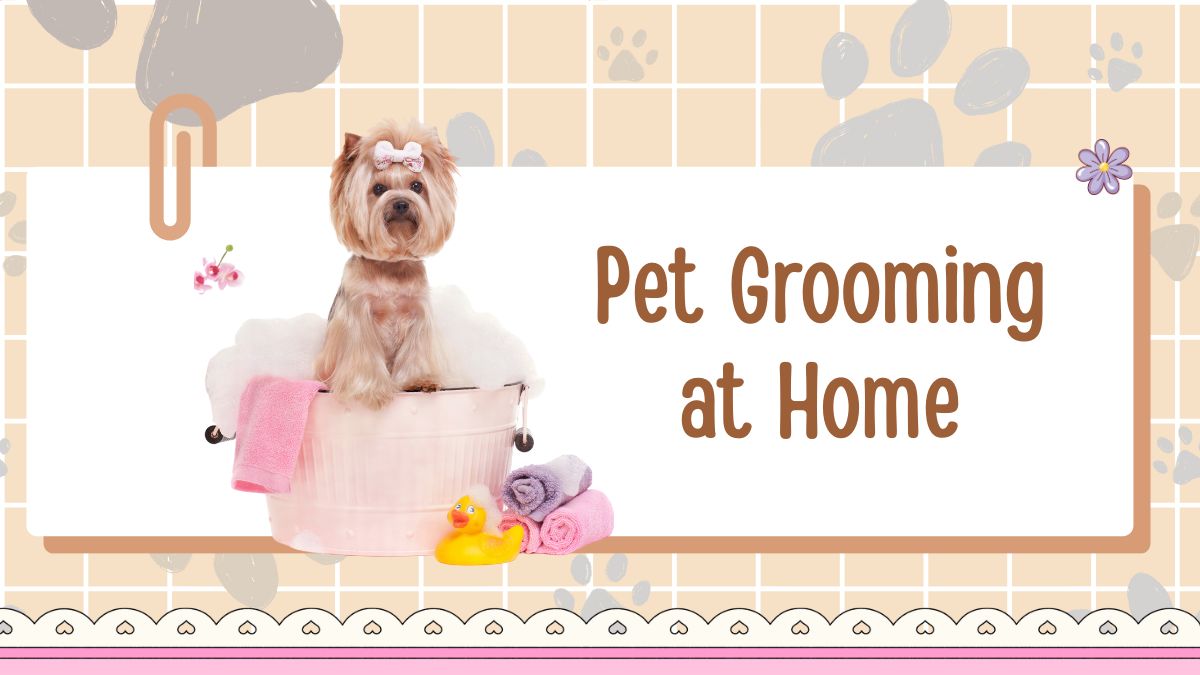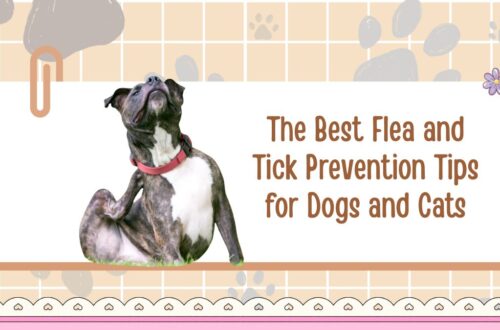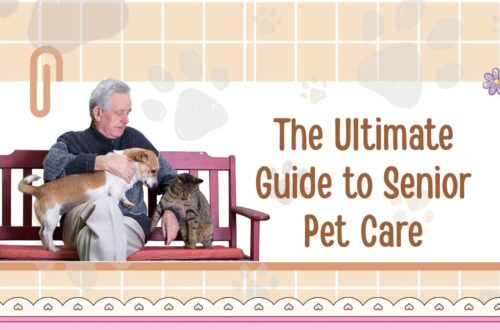Grooming your pet at home can save money, reduce stress, and help you spot health issues early.
This 2025 guide gives you updated, vet-aligned steps for dogs and cats, with checklists, pro tips, and cost figures so you can confidently build a safe, calm routine from day one.
Regular grooming supports skin health, reduces matting, and strengthens your bond.
Why Home Grooming Matters In 2025
- Health Monitoring: Brushing and handling reveal lumps, hot spots, ear redness, fleas/ticks, or broken nails before they worsen.
- Comfort & Hygiene: Regular brushing, bathing, nail care, ear/teeth cleaning maintain coat health and comfort.
- Cost Control: Professional grooming in 2025 generally costs $79–$136 per session (location, size, coat), with many providers listing breed-level prices. Learning safe basics at home reduces frequency of pro visits.
Essential Toolkit For At-Home Grooming
Must-Have Basics
- Slicker Brush / Comb: Removes loose fur, reduces tangles and matting.
- Pet-Safe Shampoo & Conditioner: Avoid human products; choose hypoallergenic pet formulas.
- Nail Clippers Or Quiet Nail Grinder (+ styptic powder for nicks).
- Microfiber Towels & Non-Slip Mat: Safety in tub.
- Ear Cleaner & Cotton Balls/Gauze (never deep swabs).
- Toothbrush & Pet Toothpaste (enzymatic preferred).
- High-velocity dryer (pet-rated) or low-heat dryer held at a distance; always avoid face and ears.
Quick Frequency Guide (Dogs)
- Brushing: Daily for long-haired; several times weekly for others.
- Bathing: Occasional based on coat/odor; non-shedding breeds often every 6–8 weeks; double-coated dogs benefit from seasonal baths during shed periods.
- Nails: Every 2–4 weeks (or when you hear clicking on floors).
- Ears/Teeth: Weekly ear checks; dental brushing several times per week.
Quick Frequency Guide (Cats)
- Brushing: Short-coat: 1–3×/week; long-coat: daily if prone to mats.
- Bathing: Only when needed or if recommended; ensure calm, brief sessions; trim claws beforehand and keep cotton in ears to keep water out.
Step-By-Step: Dog Grooming At Home
1) Set The Stage
Create a calm, reward-based environment. Let your dog explore tools, pair with treats, and keep early sessions short to build positive associations.
2) Pre-Check Health & Coats
Run hands over your dog to check for knots, burrs, fleas/ticks, tender spots, ear odor, or skin irritation. If you find pain, open sores, or severe mats, pause and consult a vet/groomer.
3) Brushing & Dematting
- Start at the neck and work with the grain.
- Use a slicker for topcoat and a comb for finishing/undercoat checks.
- For small tangles, hold hair near the skin to avoid tugging.
- For double coats, use tools designed for undercoat and consider extra brushing during spring/fall shed.
4) Bathing
- Place a non-slip mat in the tub.
- Wet with lukewarm water; avoid eyes/ears/nose/mouth; use a washcloth for the face.
- Lather pet shampoo diluted per label; rinse thoroughly until water runs clear.
- Towel dry; use a pet-rated dryer on low/medium from a distance, keeping airflow off face and ear canals.
5) Ear Care
- After baths/swims, apply ear cleaner on a cotton ball/gauze; wipe outer ear and crevices only. Do not insert swabs deep into ear canal. This helps dry residual moisture and reduce infection risk.
6) Nail Trimming (Or Grinding)
- Gently extend the nail by pressing thumb on the pad and forefinger above the nail.
- Clip just the tip, straight across, watching for the pink quick in light nails. Keep styptic powder nearby. For dark nails, trim small slivers and stop when a gray/white oval appears.
- Consider a quiet grinder for tiny, controlled reductions if you’re worried about the quick.
7) Coat Finishing & Paws
- Trim feathering or stray hairs with blunt-tip scissors if needed (only if you’re comfortable).
- Check paw pads for matting between toes; snip carefully if visible and safe.
8) Dental Basics
- Introduce a pet-safe enzymatic toothpaste; lift lip and brush the outer surfaces of canines and molars with gentle circles 2–3×/week.
Step-By-Step: Cat Grooming At Home
1) Keep It Short & Sweet
Cats prefer brief sessions. Try a few strokes daily; pair with quiet praise and treats.
2) Brushing
- Use a soft bristle, slicker, or grooming glove based on coat type; daily for long-haired breeds to prevent mats and hairballs.
3) Bathing (Only When Necessary)
- Trim claws first.
- Brush out loose fur and place cotton in ears to keep water out.
- Use lukewarm water and a cat-safe shampoo; rinse thoroughly; keep session brief and calm.
4) Nails & Ears
- Clip just the tip of each claw, avoiding the quick.
- Wipe outer ear with pet ear cleaner on cotton; do not probe deeply.
Safety Rules You Should Never Break
- Use pet-safe shampoos only. Human shampoos can irritate skin.
- No hot air or direct face/ear blasting with dryers.
- Stop if you see pain, bleeding, foul ear odor, or hot spots—consult a professional.
- Avoid close clipping of double coats (can affect insulation and regrowth).
- Reward generously; end sessions before your pet loses patience (especially cats).
2025 Costs: DIY Vs. Professional Grooming
While many pet parents handle brushing, basic baths, and nail care at home, some still schedule periodic professional sessions for breed cuts, severe mat removal, or deshedding treatments.
- Average U.S. grooming session (2025): $79–$136 per dog.
- Other price snapshots in 2025 show $30–$150+ depending on breed, size, and services; some salons publish breed-specific menus (e.g., Malamute $170, Afghan Hound $135). Home basics can significantly reduce how often you need the full works.
Tipping norms still hover around 10–20% where custom and service quality warrant it.
Dog & Cat Grooming: Quick Reference Table (2025)
| Topic | Dogs – What To Do | Cats – What To Do | Key Notes |
|---|---|---|---|
| Brushing | Daily for long coats; several times weekly otherwise | Short coat 1–3×/week; long coat daily | Reduces matting, shedding, detects skin issues. |
| Bathing | Occasional; 6–8 weeks common for non-shedding breeds; seasonal for double coats | Only when needed; keep sessions brief | Use pet shampoo; avoid face/ears; rinse thoroughly. |
| Nails | Every 2–4 weeks; clip tips only or use grinder | Trim tips; avoid quick | Keep styptic powder ready; reward frequently. |
| Ears | After baths/swims, use ear cleaner on cotton; wipe outer ear only | Wipe outer ear with cleaner; keep water out | Prevents moisture-related infections. |
| Teeth | Brush several times/week | Same | Use pet toothpaste; never human toothpaste. |
| DIY vs Pro Costs (2025) | $79–$136 average per session; some breeds $130–$170+ | Cat grooms vary; brush at home to reduce needs | DIY basics cut frequency of salon visits. |
Troubleshooting Common Beginner Problems
- My pet hates nail trims. Practice paw desensitization daily with treats; trim one nail per day until tolerance builds; switch to a quiet grinder for micro-trims.
- Endless shedding. Increase brushing frequency, use proper undercoat tools for double coats, and consider a seasonal deshed during spring/fall.
- Matting behind ears/under legs. Pre-brush before baths; hold fur near skin when detangling to reduce pull; severe mats may require a professional.
- Ear odor or head shaking. Stop DIY cleaning and see your vet; infections need medication.
Sample 30-Minute Beginner Routine (Dog)
- 2 min – Calm Setup: Treats ready, tools visible, non-slip mat down.
- 8 min – Brushing: Slicker + comb check.
- 8 min – Quick Bath: Lukewarm water; dilute pet shampoo; rinse clear; towel.
- 5 min – Ear Wipe: Cleaner on cotton; outer ear only.
- 5 min – Nails: Tip-only trim or brief grind on front paws (finish others tomorrow).
- 2 min – Reward/Notes: Treats; note any skin/ear/nail issues to recheck.
Tip: Break nails across days to keep sessions stress-free.
When To Book A Professional
- You need breed-specific clips (Poodles, Doodles, terriers).
- There’s severe matting, impacted undercoat, or skin lesions.
- Your pet has special medical needs or behavioral fear around tools.
- You lack safe tools (e.g., no dryer suitable for double coats).
Given 2025 pricing, you might reserve pros for seasonal full grooms and handle weekly maintenance at home to stretch appointments.
2025 Shopping Snapshot (Optional)
- Nail Grinders: Helpful for quick-shy pets; introduce gradually with treats.
- Brushes For Cats: 2025 tests highlight ergonomic bristle and slicker designs that reduce hairballs and shedding—use whichever your cat tolerates best.
At-home pet grooming in 2025 is absolutely achievable for beginners. With pet-safe products, a calm, reward-based approach, and attention to brushing, bathing, nails, and ears, you’ll keep your pet comfortable while catching minor issues early.
Use pros strategically for specialty clips or complex mats, and lean on your weekly maintenance routine to keep costs down and your companion feeling great. Start small, stay patient, and your pet will soon view grooming as just another loving part of life with you.
FAQs
Most dogs need occasional baths—often every 6–8 weeks for non-shedding breeds and during seasonal shedding for double-coated breeds. Always judge by coat/odor, and brush more frequently than you bathe.
Many beginners find a quiet grinder less stressful because it removes small increments, reducing the risk of cutting the quick. Keep sessions short, reward often, and keep styptic powder nearby just in case.
Expect around $79–$136 per dog session on average (more for large/difficult coats or specialty cuts). Doing brushing, ear care, and nails at home can reduce how often you need full service.




